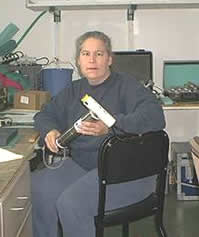| |
| |

Chemist Geoff Lebon and Marine Tech Daryl
Swenson attaching an
instrument to the mooring line.

Oceanographer Sharon Walker with a MAPR that's used to gather temperature,
pressure, and light scattering data from the water column.
|
|
Teacher Logbook - R/V Wecoma
Missy
Holzer 's Sealog:
CTD Cruise Day 9
Weather at 1630 hours PDT:
Overcast skies with winds of 22 knots from the north by northwest, and
visibility of 10 miles. Barometric pressure is 1027.3 mb, and the temperature
is 58 degrees Fahrenheit. Ocean swells are 4 feet out of the northwest,
and the seas are 8 feet out of the north by northwest.
What kind
of hydrothermal activity can be expected over the next year? That's a
question the science crew has set out to explore as they continue their
quest to extend their data set into the future. Over the past couple of
days a number of moorings with computer operated instruments (MAPR's,
MTR's etc.) were deployed in the Axial volcano area. The instruments have
been calibrated and set to gather data from the water column every 30
minutes for the next year.
Data acquisition
in oceanography has changed immensely over the years from towing instruments
from the back of a ship to computer operated instruments that can not
only explore the water column over time, but can also roam the ocean floor.
Someone who has seen a few of these changes over her career is oceanographer
Sharon Walker. Ms. Walker began her career with Dr. Baker's Hydrothermal
Plume Studies Group over 20 years ago as an undergraduate student, although
they weren't studying hydrothermal plumes at the time. When she started,
the focus of the study was the mass distribution of transported particles
in the Puget Sound and Bering Sea areas, and since 1984-1985 the focus
shifted to hydrothermal vents. Although she has always used automated
instrumentation in her studies, now her responsibilities have shifted
to being responsible for writing the software that runs the automated
instruments. The engineering department at the PMEL NOAA lab developed
the MAPR's, while Ms. Walker developed the software so that a desktop
computer can communicate with the instruments before they are deployed
and after they are recovered. Once the instruments are recovered they
can be connected to a PC and the data from the past year can be displayed
on the screen in a format that is friendly to the user. The MAPR is such
a compact instrument (about 40cm long) and the software so easy to use
that it has gone on other expeditions outside the hydrothermal study group.
MAPR's have been to the Arctic, Indian Ocean, New Zealand, South Pacific,
etc., and have rode piggyback to instruments employed for other scientific
research, and brought back interesting water column data for the hydrothermal
group.
If the instruments
are gathering data every 30 minutes for a year, there is quite a bit of
data to be managed. Ms. Walker has the responsibility of data acquisition
and data management, and she does so by using a variety of forms and filing
systems. Her work isn't complete once the data is filed; she also combines
different data sets to create graphical displays of the data. For example,
Ms. Walker combines the navigation data with the CTD data to produce a
pictorial representation of what the ocean column looks like in the area
under study. Being the computer programmer in the group has brought Ms.
Walker the enjoyable challenge of being the troubleshooter in the group;
if software is needed, she can develop a program.
Organizing
equipment for cruises is another one of the many tasks that Ms. Walker
undertakes at the PMEL NOAA lab. Lists and systems have been developed
to facilitate the preparations for the cruise, so preparing for the scheduled
cruises has almost become a routine event. What happens when the hydrophones
near the plate boundaries signal that seismic activity is occurring near
one of the ridges? The "response cruise" must be ready in 7
to 10 days to cruise out to the site and survey the area for hydrothermal
activity. The test for the response cruise came in April 2001 when the
word was out that there was seismic activity in the Gorda Ridge area of
the Juan de Fuca Ridge. The ship was secured and the equipment loaded
within 7 days. This was a satisfying feat for Ms. Walker and the Hydrothermal
Plume Study Group. Ms. Walker is happy to be in this program since she
finds a lot interest and enjoyment in what she does. She is a valuable
contributor to the progress of the group, and they are fortunate to have
her experience and dedication adding to their efforts.
|
|

